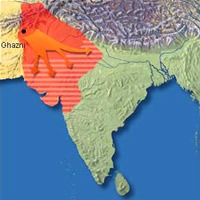Alptigin, one of the Turkish slaves of the Samanid ruler, Abdul Malik, rose to the status of Governor of Khurasan. However, when his patron died, he was striped of his title and forced to leave the land. He captured a small area in Afghanistan and established his rule in the city-state of Ghazni in 962 with the aim of conquering his own land, a desire that remained in the hearts of his successors. After his death in 977, his son-in-law, Subuktigin, succeeded him. Under Subuktigin, Ghazni started emerging as a political and military power of the region. Alarmed at the rising power in the neighborhood, the Hindu Shahi Raja Jaipal attacked Ghazni. Jaipal was defeated. In order to save his life, he promised to pay tribute. But after going back home, he not only defaulted but also took support from other Hindu Rajas of the region and again attacked Subuktigin in 991. His fate was not different this time. He was defeated and had to pay a heavy ransom besides giving away the areas of Lamghan and Peshawar.
Meanwhile, Subuktigin died and his son Mahmud ascended the throne in 998. Jaipal took advantage of the situation, and to avenge his defeat at the hands of Subuktigin, organized an army of twelve thousand horsemen, thirty thousand foot soldiers and three hundred elephants. This movement forced Mahmud, who was preparing to invade Central Asia, to turn his attention towards India. The battle against Jaipal was the beginning of a long series of attacks by Mahmud against South Asia. According to most historians, Mahmud invaded India seventeen times to crush the power of the Hindu Rajas and Maharajas who were always busy planning conspiracies against him. After defeating Tarnochalpal in 1021, Mahmud formally annexed Punjab. After the fall of Punjab, the Hindu think tank assembled at Somnath – which was more of a political center than a temple – to plan a big war against Mahmud. He took all the Rajas and Maharajas by surprise when he attacked Somnath and crushed the Hindu headquarter of political intrigue. With the destruction of Somnath he broke the backbone of the Hindus in the region and thus had no need to attack India again. Mahmud also obtained formal recognition of his sovereignty from the Abbasid Khalifah, al-Qadir Billah, who also conferred upon him the titles of Yamin-ud-Dawlah and Amin-ul-Millah. He spent his last five years in dealing with the affairs of Ghazni and in making plans to conquer Central Asia.
The most important impact of Mahmud’s expeditions was the conquest of Punjab for the first time by Muslims and the establishment of Muslim rule and society in the region. Along with Muslim warriors came Muslim saints and Sufis, who promulgated Islam in India. The most important amongst them was Sheikh Ali Hajweri, popularly known as Data Ganj Baksh. He was a renowned Sufi who not only spread the message of Allah in Lahore but also in other parts of Punjab. His book in Persian titled Kashaful-Mahjub is considered as the first authentic book on Sufism.
The establishment of Muslim rule in Punjab is a significant event in the history of Islam in Sub-continent. Muslims gained their first foothold in Northern Indian. The conquest of Punjab also paved the way for other conquerors like Muhammad Ghuri. After the death of Mahmud, the Ghaznavid dynasty lost much of its vigor; yet during the days of his son Masud and grandson Mahmud, Lahore remained an important province of the Ghaznavid Empire. Later, the Ghaznavid rulers moved their headquarter from Ghazni to Punjab and ruled Peshawar, Lahore and Multan till the last half of 12th century when Muhammad Ghuri defeated them.
This article was last updated on Sunday, June 01, 2003



